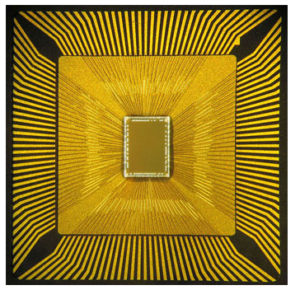A Brainy New Chip Could Make Computers More Like Humans
What’s the News: Researchers at IBM have developed a new “cognitive computing” microchip inspired by the brain’s computational tricks. These new chips, the researchers say, could make processors that are more powerful and more efficient than today’s computers—and better at the flexible learning and responses that are a struggle for current AI systems but a breeze for the human brain.
How the Heck:
IBM has made two prototypes of the new chip, which it calls a “neurosynaptic core.” Both are built on a standard semiconductor platform with 256 “neurons,” the chip’s computational components.RAM units on the chip act as synapses; one of the chips has 262,144 synapses, while the other has 65,536.
These networks take after the brain in two key ways, says Dharmendra Modha, the project leader at IBM. The hardware for memory and computation are quite close together (as they are in the brain, where neurons are responsible for both) and the connections between them form, strengthen, and weaken based on learning and experience, just like synapses between neurons.
Other than that, the researchers haven’t yet shared many specifics on how the chips work or what they can do. At a conference next month, the team plans to present studies that show these “neural cores” not only use little power, but can play Pong, recognize pictures, and steer a car along a simple track.
What’s the Context:
Today’s computers are built on von Neumann architecture, in which portals shared between inputs and outputs create a bottleneck that limits speed and performance. IBM’s neurosynaptic core design gets rid of that bottleneck by putting computation and memory together, neuron-style.
The researchers make clear they’re not trying to build a computer that works just like the human brain. Instead, they’re drawing inspiration from the brain, trying to make a system that can be flexible and adaptable.
The Future Holds:
In the long term, IBM wants to build a system that has 10 billion neurons and 100 trillion synapses (as many synapses and a tenth as many neurons as the human brain), uses just one kilowatt of power, and can fit in a shoebox.
Ultimately, Modha told Popular Science, cognitive computers would be able to combine lots of inputs and make sense of them, the way the human brain does: taking into account the firmness, color, and odor of a piece of produce, say, to tell whether it’s ripe or rotten.
Brain-inspired computers would be a complement to, rather than a replacement for, today’s systems, Modha told Wired.com:
http://blogs.discovermagazine.com/80beats/2011/08/19/a-brainy-new-chip-could-make-computers-more-like-humans/




